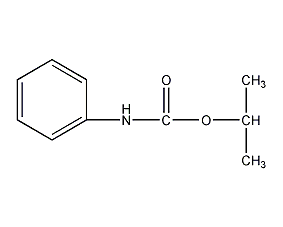
Structural formula
| Business number | 03F0 |
|---|---|
| Molecular formula | C10H13NO2 |
| Molecular weight | 179.22 |
| label |
Isopropyl anilinoformate, N-Phenylisopropylcarbamate, Isopropyl phenylcarbamate, Phenylcarbamic acid-1-methylethyl ester, cumene carbamate, Isopropyl phenylcarbamate, Agermin,Collavin,Tixit,Tuberit, herbicide, Rust Remover |
Numbering system
CAS number:122-42-9
MDL number:MFCD00026382
EINECS number:204-542-0
RTECS number:FD9100000
BRN number:2209666
PubChem ID:None
Physical property data
1. Character: colorless crystal
2. Density (g/mL ,25/4℃): 1.09
3. Melting point (℃):87~88
4. Boiling point (ºC):262
5. Solubility:20℃solubility in water for250mg/L, soluble in most organic Solvent.
6. Stability:Stable when stored at room temperature and non-corrosive. It will decompose when exposed to acid, alkali or strong heat.
Toxicological data
None yet
Ecological data
None yet
Molecular structure data
1. Molar refractive index:51.49
2. Molar Volume(m3/mol):162.2
3. Isotonic specific volume(90.2K):407.6
4. Surface tension(dyne/cm):39.8
5. Dielectric constant:
Molar refractive index:51.49
2. Molar Volume(m3/mol):162.2
3. Isotonic specific volume(90.2K):407.6
4. Surface tension(dyne/cm):39.8
5. Dielectric constant:
6. Dipole moment(10-24cm3) :
7. Polarizability:20.41
Compute chemical data
1. Reference value for hydrophobic parameter calculation (XlogP): None
2. Number of hydrogen bond donors: 1
3. Number of hydrogen bond acceptors: 2
4. Number of rotatable chemical bonds: 3
5. Number of tautomers: 2
6. Topological molecule polar surface area 38.3
7. Number of heavy atoms: 13
8. Surface charge: 0
9. Complexity: 162
10. Number of isotope atoms: 0
11. Determine the number of atomic stereocenters: 0
12. Uncertain number of atomic stereocenters: 0
13. Determine the number of chemical bond stereocenters: 0
14. Number of uncertain chemical bond stereocenters: 0
15. Number of covalent bond units: 1
Properties and stability
Storage method
None yet
Synthesis method
1. Introduction to production methods
Produced by the reaction of phenyl isocyanate and isopropyl alcohol, or by the reaction of isopropyl chloroformate and aniline
Purpose
2. Purpose
For soybeans, sugar beets, cotton, To control annual grass weeds in vegetables and tobacco fields, the dosage is2.25 ~5kg/ha.6.0pt; mso-margin-top-alt: auto; mso-margin-bottom-alt: auto” align=left>6. Dipole moment(10-24cm3):
7. Polarizability:20.41
Compute chemical data
1. Reference value for hydrophobic parameter calculation (XlogP): None
2. Number of hydrogen bond donors: 1
3. Number of hydrogen bond acceptors: 2
4. Number of rotatable chemical bonds: 3
5. Number of tautomers: 2
6. Topological molecule polar surface area 38.3
7. Number of heavy atoms: 13
8. Surface charge: 0
9. Complexity: 162
10. Number of isotope atoms: 0
11. Determine the number of atomic stereocenters: 0
12. Uncertain number of atomic stereocenters: 0
13. Determine the number of chemical bond stereocenters: 0
14. Number of uncertain chemical bond stereocenters: 0
15. Number of covalent bond units: 1
Properties and stability
Storage method
None yet
Synthesis method
1. Introduction to production methods
Produced by the reaction of phenyl isocyanate and isopropyl alcohol, or by the reaction of isopropyl chloroformate and aniline
Purpose
2. Purpose
For soybeans, sugar beets, cotton, To control annual grass weeds in vegetables and tobacco fields, the dosage is2.25 ~5kg/ha.so-bidi-language: AR-SA”>2.25~5kg/ha.

 微信扫一扫打赏
微信扫一扫打赏

